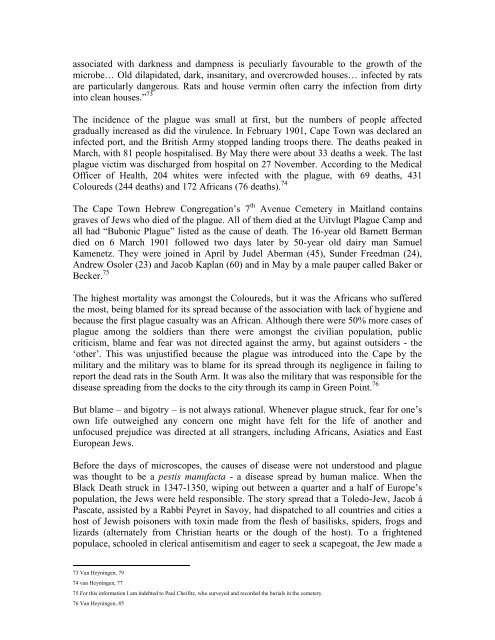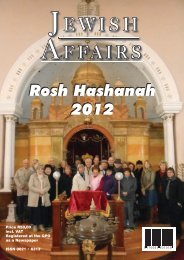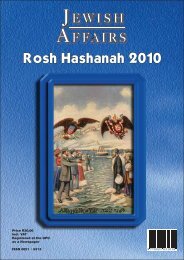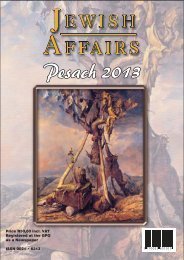ja chank 2008 - South African Jewish Board of Deputies
ja chank 2008 - South African Jewish Board of Deputies
ja chank 2008 - South African Jewish Board of Deputies
Create successful ePaper yourself
Turn your PDF publications into a flip-book with our unique Google optimized e-Paper software.
associated with darkness and dampness is peculiarly favourable to the growth <strong>of</strong> the<br />
microbe… Old dilapidated, dark, insanitary, and overcrowded houses… infected by rats<br />
are particularly dangerous. Rats and house vermin <strong>of</strong>ten carry the infection from dirty<br />
into clean houses.” 73<br />
The incidence <strong>of</strong> the plague was small at first, but the numbers <strong>of</strong> people affected<br />
gradually increased as did the virulence. In February 1901, Cape Town was declared an<br />
infected port, and the British Army stopped landing troops there. The deaths peaked in<br />
March, with 81 people hospitalised. By May there were about 33 deaths a week. The last<br />
plague victim was discharged from hospital on 27 November. According to the Medical<br />
Officer <strong>of</strong> Health, 204 whites were infected with the plague, with 69 deaths, 431<br />
Coloureds (244 deaths) and 172 <strong>African</strong>s (76 deaths). 74<br />
The Cape Town Hebrew Congregation’s 7 th Avenue Cemetery in Maitland contains<br />
graves <strong>of</strong> Jews who died <strong>of</strong> the plague. All <strong>of</strong> them died at the Uitvlugt Plague Camp and<br />
all had “Bubonic Plague” listed as the cause <strong>of</strong> death. The 16-year old Barnett Berman<br />
died on 6 March 1901 followed two days later by 50-year old dairy man Samuel<br />
Kamenetz. They were joined in April by Judel Aberman (45), Sunder Freedman (24),<br />
Andrew Osoler (23) and Jacob Kaplan (60) and in May by a male pauper called Baker or<br />
Becker. 75<br />
The highest mortality was amongst the Coloureds, but it was the <strong>African</strong>s who suffered<br />
the most, being blamed for its spread because <strong>of</strong> the association with lack <strong>of</strong> hygiene and<br />
because the first plague casualty was an <strong>African</strong>. Although there were 50% more cases <strong>of</strong><br />
plague among the soldiers than there were amongst the civilian population, public<br />
criticism, blame and fear was not directed against the army, but against outsiders - the<br />
‘other’. This was unjustified because the plague was introduced into the Cape by the<br />
military and the military was to blame for its spread through its negligence in failing to<br />
report the dead rats in the <strong>South</strong> Arm. It was also the military that was responsible for the<br />
disease spreading from the docks to the city through its camp in Green Point. 76<br />
But blame – and bigotry – is not always rational. Whenever plague struck, fear for one’s<br />
own life outweighed any concern one might have felt for the life <strong>of</strong> another and<br />
unfocused prejudice was directed at all strangers, including <strong>African</strong>s, Asiatics and East<br />
European Jews.<br />
Before the days <strong>of</strong> microscopes, the causes <strong>of</strong> disease were not understood and plague<br />
was thought to be a pestis manufacta - a disease spread by human malice. When the<br />
Black Death struck in 1347-1350, wiping out between a quarter and a half <strong>of</strong> Europe’s<br />
population, the Jews were held responsible. The story spread that a Toledo-Jew, Jacob á<br />
Pascate, assisted by a Rabbi Peyret in Savoy, had dispatched to all countries and cities a<br />
host <strong>of</strong> <strong>Jewish</strong> poisoners with toxin made from the flesh <strong>of</strong> basilisks, spiders, frogs and<br />
lizards (alternately from Christian hearts or the dough <strong>of</strong> the host). To a frightened<br />
populace, schooled in clerical antisemitism and eager to seek a scapegoat, the Jew made a<br />
73 Van Heyningen, 79<br />
74 van Heyningen, 77<br />
75 For this information I am indebted to Paul Cheifitz, who surveyed and recorded the burials in the cemetery.<br />
76 Van Heyningen, 85











